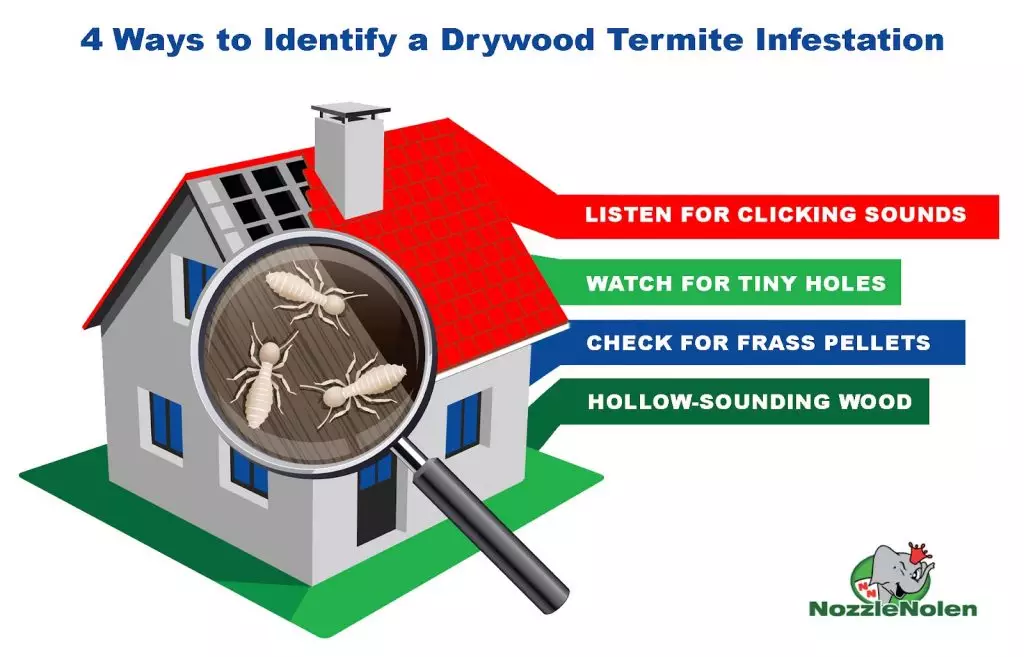 There are multiple types of pests that home and property owners in South Florida face. Knowing how to prevent drywood termites in South Florida is crucial in reducing the threat of structural wood damage and other irritations. Drywood termites are pests just like other insects and even other types of termites, but drywood termites contribute to upwards of $5 billion in damages to homes and property in Florida and the United States.
There are multiple types of pests that home and property owners in South Florida face. Knowing how to prevent drywood termites in South Florida is crucial in reducing the threat of structural wood damage and other irritations. Drywood termites are pests just like other insects and even other types of termites, but drywood termites contribute to upwards of $5 billion in damages to homes and property in Florida and the United States.
How to Identify Drywood Termites
Drywood termites will fly or “swarm” onto the structure of the building in search of a safe place to build their colony, and experienced pest control specialists look for “frass” or galleries left behind from boring activity. This frass may accumulate in small piles on areas such as window ledges, near baseboards, around door frames, or up in the attic.
Like other species, drywood termites tend to swarm after rainy weather and as temperatures rise. In South Florida, this means they begin to search for new colonies from April through July. If you see ant-like creatures that are cream or brown-colored around your property, these are likely termites. While they look like ants, they have slightly different wing shapes and body characteristics. They may also be longer, ranging in size from about one-half inch up to an inch long. Knowing what to look for is crucial for identification and treatment.
How to Prevent Drywood Termites
As the name implies, these pests feed on dry wood found in attics, door and window frames, woodpiles, and even old or second-hand furniture. Property owners who know how to prevent drywood termites in South Florida know that eliminating these risk areas with the following steps can help prevent infestations.
- Keep wood piles at least 20 feet away from the exterior of your home.
- Remove old structures like gates or fences that do not see regular use.
- Repair door and window frames and treat them with termite-specific insecticides.
- Repair and seal cracks and crevices in your home.
- Trim shrubs and bushes so that they do not come in contact with your home.
In addition to these steps, a regular inspection by a state-certified pest control expert can help identify problem areas on your property or in your home, and recommend treatments that will help protect your investment.

Do You Have an Infestation?
Since drywood termites do not leave much evidence of their arrival, especially once they have established their colony, they can be difficult to identify. As noted above, frass is not used for tunnels but is discarded outside of the colony. A checklist to determine if you have an infestation should include:
- Listening for clicking sounds—While termites are small, they are not silent. As they move around or communicate with each other, they will make faint clicking sounds.
- Verifying if there are any “kick-out” holes—Termites create tiny holes in the wood where they eject waste. These are the size of a pen tip, and on their own, may be challenging to find.
- Checking for frass pellets—Near a kick-out hole, you will likely see waste pellets. Unlike feces from rodents or other pests, frass can be a multitude of colors and will have the consistency of sawdust.
- Identifying hollow-sounding wood—If the infestation is large enough, then the destruction to a piece of wood will be noticeable. Knocking on it with a screwdriver or similar object will cause a hollow sound when compared to a solid piece of timber.
Unfortunately, these signs may be difficult to identify over the sights and sounds of everyday life without the training and certification from Florida’s Department of Agriculture and the University of Florida’s IFAS Extension.
Eradication: Professional Methods
If you haven’t established how to prevent drywood termites, there are several ways of managing an infestation. Unlike their subterranean counterpart, if caught early, drywood colonies are often isolated to one piece of wood rather than spreading throughout a home. Also when caught early, pest control specialists can treat them with a localized procedure involving drilling small holes in the affected wood and injecting a safe-for-family solution.
However, in some cases, drywood termites might be just one part of an infestation that includes many other pests. In those cases, pest control experts may urge a complete fumigation or a high-heat treatment (above 120°F). Residents of South Florida should know that it is not extremely uncommon to see live termite activity in their home—we live in the state with the second-highest number of required fumigations only behind California.
Get Expert Help to Prevent Drywood Termites
Nozzle Nolen provides a 365-day Complete Home Protection Plan to stop drywood termite invasions with strategically located treatments. Our 20-pest protocols provide year-round protection against not just drywood termites, but subterranean variants, ants, roaches, wasps, rodents and many others. In addition, our seasonal visits include on-site inspections that identify and manage any at-risk areas.
Contact us today for a free evaluation and additional resources on how to prevent drywood termites in South Florida.

